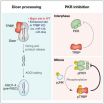(Press-News.org) AMHERST, Mass. - Using a new approach for determining the age at sexual maturity for wild stocks of western Atlantic bluefin tuna, researchers led by Molly Lutcavage of the University of Massachusetts Amherst and Gilad Heinisch of Israel's Oceanographic and Limnological Research Center, suggest that these fish mature at a considerably younger age than cuurently assumed. These findings could lead to changes in how fisheries scientists estimate the population.
Lutcavage says, "Whether a bluefin tuna or cod, for realistic fish stock assessments it's important to know at what age, where, when and how often fish spawn. Here in Gloucester and New England, it's painfully clear from the groundfish management crisis that fisheries scientists and managers must get these basics right."
In their study published on Nov. 28 in Nature's online open-access journal Scientific Reports, Lutcavage, a fisheries oceanographer and director of the Large Pelagics Research Center at UMass Amherst's Gloucester Marine Station, with her two former doctoral students Heinisch and Jessica Knapp at the University of New Hampshire, introduce a new endocrine-based approach to determine timing of sexual maturation in one of the most important commercial tuna species in the Atlantic.
Until now, sexual maturity for bluefin tuna was determined by observing fish sizes on the known spawning grounds during the known spawning season. Since bluefin tuna aggregate roughly by size for reproduction, this is like searching for expectant mothers only in hospital delivery rooms, Lutcavage says. Spawning bluefin using locations and times other than those observed in the northern Gulf of Mexico would be overlooked. This would lead to underestimating the spawning stock biomass, and bias estimates of the population's reproductive potential.
She adds, "We needed to analyze sexual maturity in bluefin of different sizes where they mix, on their feeding grounds such as the Gulf of Maine. But since this is not a breeding location, fish lack the obvious characteristics of those in spawning condition. We had to come up with a novel approach to determine maturity. Endocrine tools, recently developed in Israel for bluefin aquaculture, were just what we were looking for."
The authors state that "determining accurate maturity schedules for western Atlantic bluefin tuna is necessary for precise determination of spawning stock biomass, a proxy of reproductive potential." A major bias for determining the age of sexual maturity is the potential for biased sampling on spawning grounds, they add, but their new endocrine-profiling technique provides alternative, direct and accurate information.
Experts currently recognize two major spawning basins, the Mediterranean Sea and the northern Gulf of Mexico/Florida Straits for eastern and western Atlantic bluefin tuna stocks, Lutcavage explains. But researchers are uncertain about annual migrations, stock structure and age at sexual maturity for these fish. While the age at first reproductive cycle of eastern Atlantic bluefin tuna is well documented and occurs in three to five year-old fish the prevailing assumption for western Atlantic bluefin is that these fish do not breed before reaching nine years of age.
Lutcavage and colleagues investigate and challenge the assumption and long-held belief that such a large discrepancy exists between the two groups. "Recent studies show that bluefin in the eastern and western Atlantic grow at the same rates, eat similar prey, and can mix on the same Atlantic feeding grounds early in life. With similar life histories, it's hard to see how they could then maintain vastly different maturity schedules."
For their study, Lutcavage and colleagues sampled 110 total, (48 female, 45 male and 17 young-of-the-year (YOY)) Atlantic bluefin tuna caught in United States and Canada during May through November, 2008 to 2010.
For each fish, the researchers took the standard size measure, curved fork length (CFL) and removed and froze the pituitary gland. They also weighed the gonads with nearby fat body. Later, in the laboratory, the researchers measured luteinizing hormone (LH) and follicle-stimulating hormone (FSH) in the pituitary. Briefly, they found that "the current paradigm of widely different maturity schedules for eastern and western Atlantic bluefin tuna is incorrect."
The FSH/LH ratio, an indicator for sexual maturity in vertebrates, was, as expected, higher than 2 in the immature YOYs and lower than 0.4 in the mature large fish (greater than or equal to185 cm CFL). In the intermediate group (134-185 cm CFL), fish that are currently assumed immature, the ratio was less than 0.4, similar to the mature fish, they report. These results are also in agreement with results from Mediterranean bluefin as well as in other vertebrates, the authors say.
Overall, the endocrine results "demonstrate that Atlantic bluefin tuna of sizes 134-185 cm CFL sampled in the northwest Atlantic are sexually mature, and consequently alternative reproductive behavior scenarios for spawning locations and times should be considered." The authors conclude that "growing physiological and behavioral evidence" show maturity and reproduction markers for western Atlantic bluefin tuna must be revised, "which would contribute to more accurate stock assessments and estimates of spawning stock biomass."
INFORMATION:
http://www.nature.com/srep/2014/141128/srep07205/full/srep07205.html
December 2, 2014 - Now you don't even have live in Estonia to open a business there. A new program lets people purchase e-signatures that enable them to open bank accounts and run a domestic business without being physically present. But according to new research, people may not have the same trust in such businesses as they would others. A new paper finds that people are much more likely to discount the validity of an e-signature than a hand-signed document.
"Although e-signatures provide greater efficiency and convenience, they just seem a bit inauthentic," says Eileen ...
LOS ANGELES (Dec. 1, 2014) - Research scientists have developed a novel method to re-create brain and intestinal stem cells from patients who died decades ago, using DNA from stored blood samples to study the potential causes of debilitating illnesses such as inflammatory bowel disease.
The lab research, published in the journal STEM CELLS Translational Medicine, could yield new therapies for people who suffer from aggressive motor-neuron and gut-related conditions that proved fatal to the deceased patients who long-ago volunteered their blood samples.
"The potential ...
Philadelphia, PA, December 1, 2014 - "Triple-negative" breast cancer (TNBC) occurs in patients whose cells do not express receptors for estrogen, progesterone, and/or human epidermal growth factor receptor 2 (ER/PR/HER2). Because of the absence of these predictive biomarkers, treatment assignment can be difficult. Now, researchers report that high levels of the microRNA miR-21 in the tumor microenvironment, but not in the tumor epithelia (cancer cells), are associated with worse clinical outcomes for patients with TNBC, thus identifying a possible ...
Research at the University of Adelaide has discovered cancer cells may be particularly susceptible to metabolic stress - opening the way for new targeted therapy that won't harm normal cells.
The researchers showed that chromosomal instability - which is a hallmark of rapidly dividing cancer cells - makes them stressed and vulnerable to mild metabolic disruption. Metabolism is the normal process by which the body turns food into energy.
"A common problem in treating cancers is that they don't respond to chemotherapy, or they respond for a while, but then come back," ...
The research team of the Center for RNA Research at IBS has succeeded in revealing that the dsRNAs and Protein Kinase R (PKR) regulate division of mammalian cells.
This finding will provide important clues to understanding the process of tumor formation and the mechanism for suppressing cancer since the abnormal cell division marks the early events of cancer development.
For the first time, the IBS research team has found that during mitosis, the cellular dsRNAs activate PKR, an enzyme previously known as a trigger of immune response during virus infection. Activated ...
Inflammatory skin diseases such as psoriasis may result from abnormal activation of cell death pathways previously believed to suppress inflammation, a surprise finding that could help to develop new ways of treating these diseases.
Mr James Rickard, Associate Professor John Silke and colleagues from the Walter and Eliza Hall Institute made the discovery while investigating how cell death pathways are linked to inflammatory disease development. The study was published today in the journal eLife.
Infected cells, cancerous cells, or those that are simply unnecessary to ...
Vitamin D deficiency is not just harmful to physical health--it also might impact mental health, according to a team of researchers that has found a link between seasonal affective disorder, or SAD, and a lack of sunlight.
"Rather than being one of many factors, vitamin D could have a regulative role in the development of SAD," said Alan Stewart of the University of Georgia College of Education.
An international research partnership between UGA, the University of Pittsburgh and the Queensland University of Technology in Australia reported the finding in the November ...
URBANA, Ill. - A 12-year University of Illinois study shows that, although the use of cover crops does not improve crop yields, the practice does increase the amount of sequestered soil organic carbon using three different soil management systems.
U of I soil scientist Ken Olson evaluated plots that were subjected to no-till, chisel plow and moldboard plow treatments with and without hairy vetch and cereal rye cover crops.
"By 2012, we found that the soil tillage plots that had cover-crop treatments had more soil organic carbon stock than those without cover crops ...
ROCHESTER, Minn. -- Most patients with triple-negative breast cancer should undergo genetic testing for mutations in known breast cancer predisposition genes, including BRCA1 and BRCA2, a Mayo Clinic-led study has found. The findings come from the largest analysis to date of genetic mutations in this aggressive form of breast cancer. The results of the research appear in the Journal of Clinical Oncology.
"Clinicians need to think hard about screening all their triple-negative patients for mutations because there is a lot of value in learning that information, both in ...
Researchers from Brigham and Women's Hospital (BWH) have identified what they believe to be the cells responsible for fibrosis, the buildup of scar tissue. Fibrotic diseases, such as chronic kidney disease and failure, lung disease, heart failure and cirrhosis of the liver, are estimated to be responsible for up to 45 percent of deaths in the developed world.
The findings are published online in the journal Cell Stem Cell.
"Previous research indicated that myofibroblasts are the cells responsible for fibrosis," said Benjamin Humphreys, MD, PhD, senior author of ...




